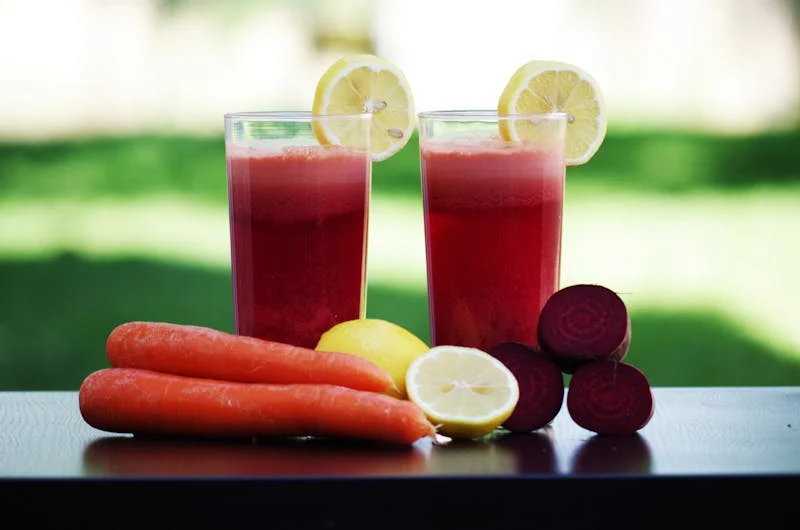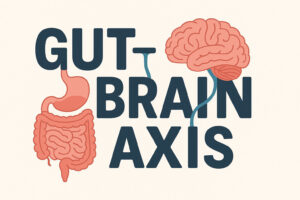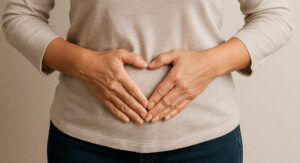Discover a delicious juice recipe that can help balance your hormones and boost your overall health. Perfect for a refreshing and nutritious drink!
Explore the rejuvenating power of a delightful juice recipe designed to harmonize your hormones and enhance your well-being. This refreshing blend not only tantalizes the taste buds but also packs a nutritional punch, making it an ideal choice for those seeking a natural boost to their health regimen. Discover how simple ingredients can come together to create a beverage that not only refreshes but also supports hormonal balance, offering a delicious way to nourish your body and invigorate your day.
You can jump to the recipe or enjoy some background research regarding how foods help us properly detoxify excess hormones and get them out of our body safely and easily. This is for men and women for both can benefit!
The detoxification of the human body is super complex and beautiful! As it turns out, foods we eat can help tremendously. I am going to try and help you understand some of the detox processes and which foods you can use in your daily life to support your hormone balance and overall well being. At the end of the article will have the recipe!
First is Phase 1 Detox
The most important thing you can do for Phase 1 detox is consume organic whole foods and drinks. This phase of detoxification is disrupted by glyphosate, which is a pervasive herbicide that disrupts our body’s ability to make all CYP Phase 1 detox enzymes and some of the Phase 2 detox enzymes as well.
For the best outcome in estrogen detoxification and therefore balance, we want to increase CYP1A enzymes as they push the 2-hydroxy estrogen detox pathway and modulate CYP1B enzymes which increase the 4-hydroxy estrogen detox pathway. (1)
Important Key Points about Phase 1 Detox
- Eat and drink 100% organic or close to it!
- To increase or induce CYP1A, one can consume cruciferous vegetables such as broccoli, cauliflower, fresh daikon radish sprouts, raw cabbage, and green tea.
- To modulate CYP1B, one can consume celery.
Next is Phase 2 Detox
Phase 2 detox comes after phase 1, and makes the potent phase 1 metabolites into inert substances that can exit the body without causing harm. There are many different categories within the Phase 2 detox pathway system and each has some foods that support it.
Glutathione
Glutathione is an important component of the Phase 2 detox pathway as it protects the body from harmful free radicals produced in the process of detoxification. Sulforphane in broccoli sprouts augments glutathione levels in the body. (2) Beetroot stimulates the GST glutathione enzymes. (3)
Glucuronidation
This hormone detox pathway can be supported by consuming cruciferous vegetables, citrus, rooibos tea, rosemary, soy, and ellagic acid from pomegranate and walnuts. (4)
Glucaric acid
This acid is found in oranges, apples, grapefruit, spinach, cucumber, celery, lettuce and cruciferous vegetables and is valuable in regards to estrogen detox. As estrogen is broken down, and conjugated via glucuronidation, and finally lands in the stool, there are bacteria that secrete an enzyme that removes the conjugation and allows estrogen to be reabsorbed. This is common when one allows oneself to be constipated, or not have at least one complete bowel movement every day. (5)
Methyl transferases (COMT gene)
Part of estrogen detoxification happens via methyl transferases. These need methylated B vitamins and magnesium to work. The best food for these is spinach. COMT enzymes are slowed down by the adrenaline released in stressful times. Therefore consumption of stimulants such as excessive caffeinated drinks will inhibit your estrogen detox. It is best to avoid stimulants if you are trying to balance your hormones. It is also best to avoid excessive alcohol. Excessive alcohol (more than 1 drink per day) can block this pathway also by burdening the ALDH pathway which will then slow down COMT.
Amino acids
To get our amino acids that are vital for detox we must eat protein containing foods! For phase 2 detox we need five important amino acids, namely glutamine, glycine, taurine, ornithine and arginine. Taurine and ornithine can be made by our bodies, the others have to be consumed in our daily diets. Sources for arginine are in pine nuts, pumpkin seeds and sunflower seeds. For glutamine you can get it from spinach, parsley and cabbage. For glycine, you can eat meat, eggs, fish and pumpkin seeds and sunflower seeds. (1)
A special note just for men, consuming pomegranate seeds with a little bit of the white pulp has been shown to increase male sex hormones, such as testosterone, follicular stimulating hormone, and luteinizing hormone. (6)
Juice Recipe for Hormone Balance
Pick Your Favorite Ingredients: (how much of each depends on your taste!)
- Broccoli stalk (2)
- Broccoli or Daikon radish sprouts (1/2cup)
- Carrot (1 large)
- Spinach (1 handful)
- Parsley (1 handful)
- Apple (1 small, cored)
- Cucumber (1-2 medium)
- Celery (3 stalks)
- Beetroot (1 medium raw)
- Cabbage (1 large leaf)
- Pomegranate (½)
- Lemon (1 whole, peeled)
- Add ginger or jalapeno for a little kick
Dilute and add ice using
- Green tea
- Rooibos tea
Detoxication Factors – Phase 1 and Phase 2 Detoxication Support; The juice of the pomegranate is a powerful antioxidant, with three times the antioxidant content of red wine. A great addition to any juice or smoothie! Don’t want to mess with raw beets, add this beet root and beet green powder instead. Beets contain betaine which supports detoxification of hormone metabolites and supports hormone balance.
While these supplements may provide support, it is essential to have your hormones thoroughly tested and evaluated by myself or another Naturopathic Physician. For optimal well-being, working with Dr. Wells allows for uncovering the root cause of your imbalance and creating a personalized treatment plan to address it effectively, ensuring long-term hormonal health.
References
- Hodges RE, Minich DM. Modulation of Metabolic Detoxification Pathways Using Foods and Food-Derived Components: A Scientific Review with Clinical Application. J Nutr Metab. 2015;2015:760689. doi: 10.1155/2015/760689. Epub 2015 Jun 16. PMID: 26167297; PMCID: PMC4488002.
- Sedlak TW, Nucifora LG, Koga M, Shaffer LS, Higgs C, Tanaka T, Wang AM, Coughlin JM, Barker PB, Fahey JW, Sawa A. Sulforaphane Augments Glutathione and Influences Brain Metabolites in Human Subjects: A Clinical Pilot Study. Mol Neuropsychiatry. 2018 May;3(4):214-222. doi: 10.1159/000487639. Epub 2018 Apr 17. PMID: 29888232; PMCID: PMC5981770.
- Clifford T, Howatson G, West DJ, Stevenson EJ. The potential benefits of red beetroot supplementation in health and disease. Nutrients. 2015 Apr 14;7(4):2801-22. doi: 10.3390/nu7042801. PMID: 25875121; PMCID: PMC4425174.
- Vitamin B Food sources: https://www.tataaig.com/knowledge-center/health-insurance/vitamin-b-rich-foods
- Calcium D glucarate monograph; https://altmedrev.com/wp-content/uploads/2019/02/v7-4-336.pdf
- Khalid W, Arshad MS, Ranjha MMAN, Różańska MB, Irfan S, Shafique B, Rahim MA, Khalid MZ, Abdi G, Kowalczewski PŁ. Functional constituents of plant-based foods boost immunity against acute and chronic disorders. Open Life Sci. 2022 Sep 8;17(1):1075-1093. doi: 10.1515/biol-2022-0104. PMID: 36133422; PMCID: PMC9462539.

Hi I’m Dr. Wendy Wells, a licensed Naturopathic Physician in Arizona in the United States. I was awarded a Doctorate of Naturopathic Medicine from Southwest College of Naturopathic Medicine, now called Sonoran University. I’m a member of the American Association of Naturopathic Physicians and the Arizona Board of Naturopathic Medical Association. I enjoy helping patients with a variety of acute and chronic issues such as thyroid issues, hormone balancing, chronic fatigue, food sensitivities, gut health, mental health, autoimmune and skin issues. My passion is finding the source beneath any health concerns, getting the body back in balance, educating patients and their communities about how the body heals itself, and setting a course for continued wellness going forward.
Reclaim Your Energy with Dr. Wells
Feeling constantly tired or low on energy? Discover the root causes of your fatigue and unlock your path to renewed vitality with a personalized consultation. Dr. Wendy Wells, a licensed naturopathic physician, will provide expert insights and tailored solutions to help you feel your best. Don’t wait—schedule your free consultation today and take the first step towards a healthier, more energetic life!
Learn More Health Tips and Tricks
Fatigue Before Your Period? You’re Not Alone. Here’s What Your Body Might Be Telling You
Do you feel exhausted, headachy, or even nauseous in the days before your period? If so, you’re not alone. Many…
Read MoreFatigue ICD-10 Code & Why It Matters: More Than Just a Diagnosis
Fatigue is one of the most common complaints in modern medicine. But despite how widespread it is, fatigue is often…
Read MoreVagus Nerve Signaling: The Gut-Brain Superhighway
When you have a ”gut feeling”, you’re not imagining things, your nervous system is actually listening and trying to get…
Read MoreProbiotics and Short Chain Fatty Acids: The Good News
Good bacteria species such as Clostridia, Bacteroides, Lactobacillus, Bifidobacterium and Akkermansia species ferment the fiber from our diet and secrete…
Read More




